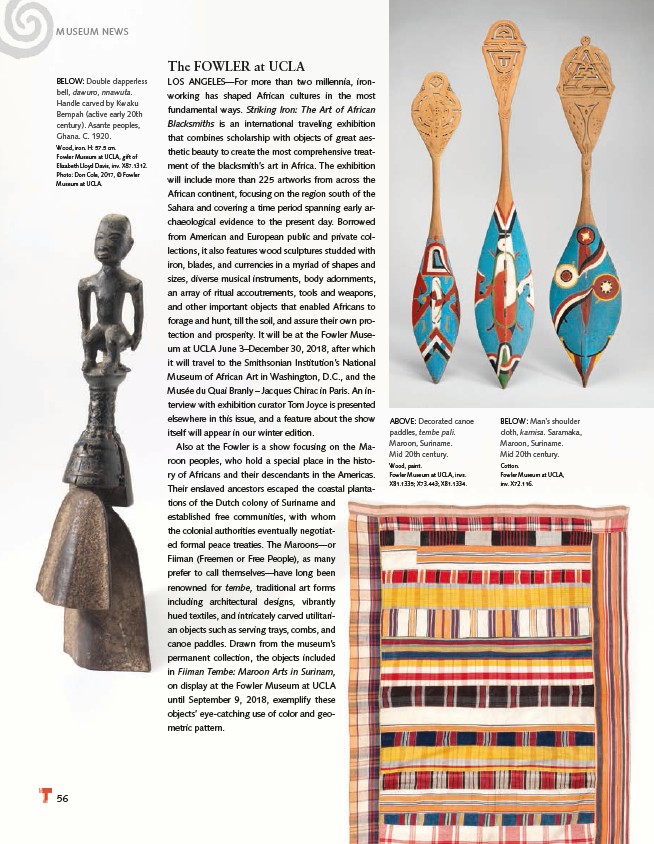
MUSEUM NEWS
56
The FOWLER at UCLA
LOS ANGELES—For more than two millennia, ironworking
has shaped African cultures in the most
fundamental ways. Striking Iron: The Art of African
Blacksmiths is an international traveling exhibition
that combines scholarship with objects of great aesthetic
beauty to create the most comprehensive treatment
of the blacksmith’s art in Africa. The exhibition
will include more than 225 artworks from across the
African continent, focusing on the region south of the
Sahara and covering a time period spanning early archaeological
evidence to the present day. Borrowed
from American and European public and private collections,
it also features wood sculptures studded with
iron, blades, and currencies in a myriad of shapes and
sizes, diverse musical instruments, body adornments,
an array of ritual accoutrements, tools and weapons,
and other important objects that enabled Africans to
forage and hunt, till the soil, and assure their own protection
and prosperity. It will be at the Fowler Museum
at UCLA June 3–December 30, 2018, after which
it will travel to the Smithsonian Institution’s National
Museum of African Art in Washington, D.C., and the
Musée du Quai Branly – Jacques Chirac in Paris. An interview
with exhibition curator Tom Joyce is presented
elsewhere in this issue, and a feature about the show
itself will appear in our winter edition.
Also at the Fowler is a show focusing on the Maroon
peoples, who hold a special place in the history
of Africans and their descendants in the Americas.
Their enslaved ancestors escaped the coastal plantations
of the Dutch colony of Suriname and
established free communities, with whom
the colonial authorities eventually negotiated
formal peace treaties. The Maroons—or
Fiiman (Freemen or Free People), as many
prefer to call themselves—have long been
renowned for tembe, traditional art forms
including architectural designs, vibrantly
hued textiles, and intricately carved utilitarian
objects such as serving trays, combs, and
canoe paddles. Drawn from the museum’s
permanent collection, the objects included
in Fiiman Tembe: Maroon Arts in Surinam,
on display at the Fowler Museum at UCLA
until September 9, 2018, exemplify these
objects’ eye-catching use of color and geometric
pattern.
BELOW: Double clapperless
bell, dawuro, nnawuta.
Handle carved by Kwaku
Bempah (active early 20th
century). Asante peoples,
Ghana. C. 1920.
Wood, iron. H: 57.5 cm.
Fowler Museum at UCLA, gift of
Elizabeth Lloyd Davis, inv. X87.1312.
Photo: Don Cole, 2017, © Fowler
Museum at UCLA.
BELOW: Man’s shoulder
cloth, kamisa. Saramaka,
Maroon, Suriname.
Mid 20th century.
Cotton.
Fowler Museum at UCLA,
inv. X72.116.
ABOVE: Decorated canoe
paddles, tembe pali.
Maroon, Suriname.
Mid 20th century.
Wood, paint.
Fowler Museum at UCLA, invs.
X81.1335; X73.443; X81.1334.